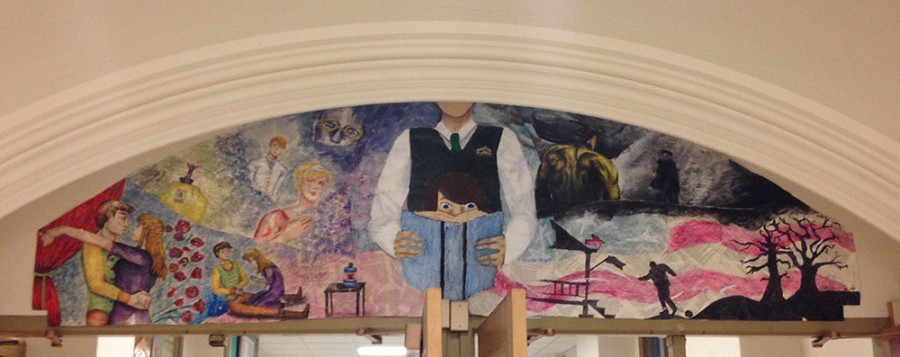Using paints, pastels, and markers, the art students connected famous scenes from literature into a colorful and imaginative piece of art. The English Literature Mural can be viewed on the fourth floor above the entrance to the English Hallway.
Artist’s Corner: New Mural Installed Dedicated to English Literature
The English Literature Mural ties both the appreciation of Art and English together as it illustrates the importance of reading.
August 17, 2015
Last year’s AP Studio Art 2D class created a mural dedicated to the English literature a student would typically read during their time at West. The class consisted of eleven students, ten of them seniors at the time and the last member, Kaylee Holecek, a senior this year. The class worked on the mural for the last two weeks of school and this summer it was installed in the school. The mural is supposed to depict students reading four of the more well-known English literature at West: To Kill a Mockingbird, Romeo & Juliet, Frankenstein, and The Great Gatsby. Through this mural, the students wanted to show the importance of reading. You can find it above the double doors separating the English hall from the atrium on the fourth floor.
Mrs. Doyle, art teacher, oversaw the creation of the mural and was able to share some of her thoughts on the project.
She says, “I’m incredibly proud of my AP Studio Art 2D students who were leaders in this project from choosing the site, and developing the concept through creation. It was truly an organized, thoughtful group effort. The students wanted to not only portray the importance of reading, but also create a mural that related directly to its placement in the building: right at the entrance to the English office and classrooms. It’s a lovely marriage of Art and English.”
While murals are still prominently used and created today like those in our school, murals date back to prehistoric times when people drew pictures on the cave walls. The idea of murals has spread across the whole world, though, with old findings in Egyptian tombs and then much later in the Middle Ages. At the very beginning of the Renaissance time, the artist Michelangelo was asked by Pope Julius II to paint the Sistine Chapel which has attracted tourists for centuries now. The work of art is one of the most renowned murals in history. It depicts many biblical scenes including references to the creation story, nine scenes of Genesis, and more.
Originally Michelangelo had planned on turning down the project because he considered himself a sculptor rather than a painter, but in the end, by force, he took up the job. While the count of figures painted in the mural is not exact, numbers reach over three-hundred. A total of four years were spent on the mural and there are records stating that Michelangelo suffered depression and emotional issues afterwards due to the long time he spent on the project. In fact, he was so mentally and physically exhausted from the project that he wrote a poem about his sufferings.
Although Michelangelo seemed to not have enjoyed creating the ceiling mural, his work continues to be an attraction to many tourists. Because it was a major attraction, parts of the mural were actually restored between 1980-1999, bringing back the bright colors used in the mural. This work has defined part of what the Renaissance was and it has represented a crucial turning point in art and style.
Today, murals have evolved still to become a way to bring a community of people together under a similar topic. This idea of unity is demonstrated in the English Literature Mural at our school. So when you pass by the mural, remember that in a way it illustrates how every student at school can share something in common.
A mural can overall show a commonality between people, but the students had specifically intended to send a message through their mural as well. It was created to emphasize the importance of reading, so try to pick up a book at the library sometime or try out the optional summer reading challenge next year; it is never too late to find a good read!
